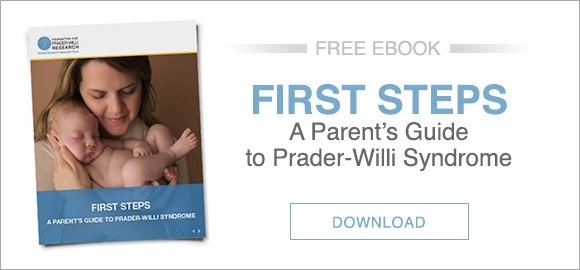 The potential overlap between PWS and symptoms of autism spectrum disorder (ASD) has been the subject of discussion and research for some time now. In the past, research found estimates of autism in people with PWS to be as high as 41%. But on June 5, 2017, a study published in the Journal of Neurodevelopmental Disorders found that children and adolescents with PWS had a rate of ASD diagnosis of just 12.3%.
The potential overlap between PWS and symptoms of autism spectrum disorder (ASD) has been the subject of discussion and research for some time now. In the past, research found estimates of autism in people with PWS to be as high as 41%. But on June 5, 2017, a study published in the Journal of Neurodevelopmental Disorders found that children and adolescents with PWS had a rate of ASD diagnosis of just 12.3%.
Previous Overestimates of Autism in People With PWS
Experts in the PWS field have long thought that the higher ASD rates published previously were likely due to an overestimate of ASD symptoms, resulting from the use of limited screening tools for ASD and indirect assessments (e.g., asking the parents about possible ASD symptoms rather than directly assessing the person with PWS). Overestimates of ASD symptoms and diagnoses in PWS can lead to using interventions that are not particularly helpful, and can also misdirect future research endeavors.
New Research By Dykens and Roof
PWS experts Elisabeth Dykens and Elizabeth Roof and their colleagues conducted the recent study to try to better understand the behavioral and social challenges as well as the diagnosis of ASD in people with PWS. This study had many strengths including a large sample size (146 children and adolescents with PWS, age range 4 to 21 yrs. old), and use of multiple ways of assessing ASD symptoms. They also had a good distribution of genetic subtypes, with 52% having PWS by deletion, 38% having PWS via uniparental disomy (UPD), with the remaining 10% having either atypical deletions or imprinting defects.
The main goal of this study was to address some of the methodological concerns of previous studies examining rates of ASD in people with PWS. They evaluated the children directly, which was an advantage over previous studies. Additionally, the authors wanted to provide a more complete characterization of children with PWS and ASD compared to those with PWS only. They used several “gold standard” ASD measures including the Autism Diagnostic Observation Schedule (ADOS-2) as well as a “best-estimate” ASD diagnosis using expert clinician reviews of ADOS-2 videotapes of the children engaging in tasks and interacting with the examiner.
The expert panel also reviewed interview data from parents about the child’s educational and developmental functioning. The panel included the PWS research team and a psychologist with expertise in ASD. The PWS research team had a lot of clinical as well as research experience with individuals with PWS. The expert review panel met regularly and discussed the data on each participant in the study, until they had agreement regarding whether the person with PWS met full criteria for the diagnosis of ASD.
This study of children and adolescents with PWS found a rate of ASD diagnosis of 12.3%. This is quite a bit lower than previous studies, which have reported rates ranging between 25 to 41%.
Importance of Multiple Screening Tools
The authors suggest that rates of ASD in previous studies may have been higher because these studies reported data from one ASD screening tool, generally completed only by parents. The screening tools used in these previous studies were meant to identify individuals who needed further evaluation to confirm diagnosis of ASD. The present study went on to the next level by fully evaluating people with PWS to determine if child met the full clinical criteria for ASD using multiple methods of assessing symptoms.
The importance of using multiple ways to evaluate the children for ASD was highlighted in this study, especially when they looked at the children with PWS who were positive on one assessment (e.g., ADOS-2) but not on another (either another screening tool or by expert panel consensus). Often the children who had this pattern of scores (positive on one of the screening tools but not meeting criteria with further assessment) had more verbal struggles. It may be that their challenges communicating artificially inflated their scores on some of the autism assessment tools.
Other Findings and Future Research
As reported in other studies of ASD in PWS, people with PWS via UPD met the criteria for ASD at a higher rate (25%) than the other genetic subtypes, but this rate of ASD is still generally lower than previously reported for individuals with UPD.
Interestingly, compulsivity and insistence on sameness in routines or events were seen in 76-100% of the participants with PWS regardless of ASD diagnosis. Clinically, these behaviors are often found to affect adaptive functioning (how well a person manages the tasks of day-to-day living) in persons with PWS and are among some of the most difficult behaviors for parents to manage.
Finally, although social impairments fell below the threshold for ASD diagnosis, many of the children with PWS who did not meet full criteria for ASD (45-70%) still exhibited some degree of challenge in reciprocal social interactions. The challenges with social interactions as well as compulsivity and insistence on sameness may be associated with other psychiatric or behavioral disorders or may be inherent to the PWS phenotype.
Future research on interventions focused on addressing compulsivity, insistence on sameness and challenges with reciprocal social interactions in people ith PWS would help us gain critical knowledge that may significantly improve the adaptive and social functioning in persons with PWS. To this end, FPWR is supporting a study on improving social functioning in persons with PWS.








